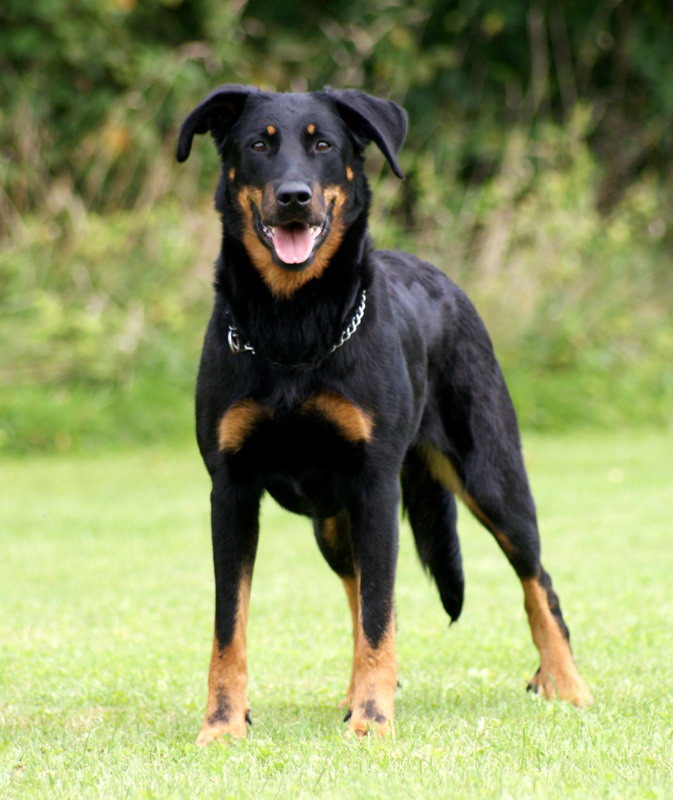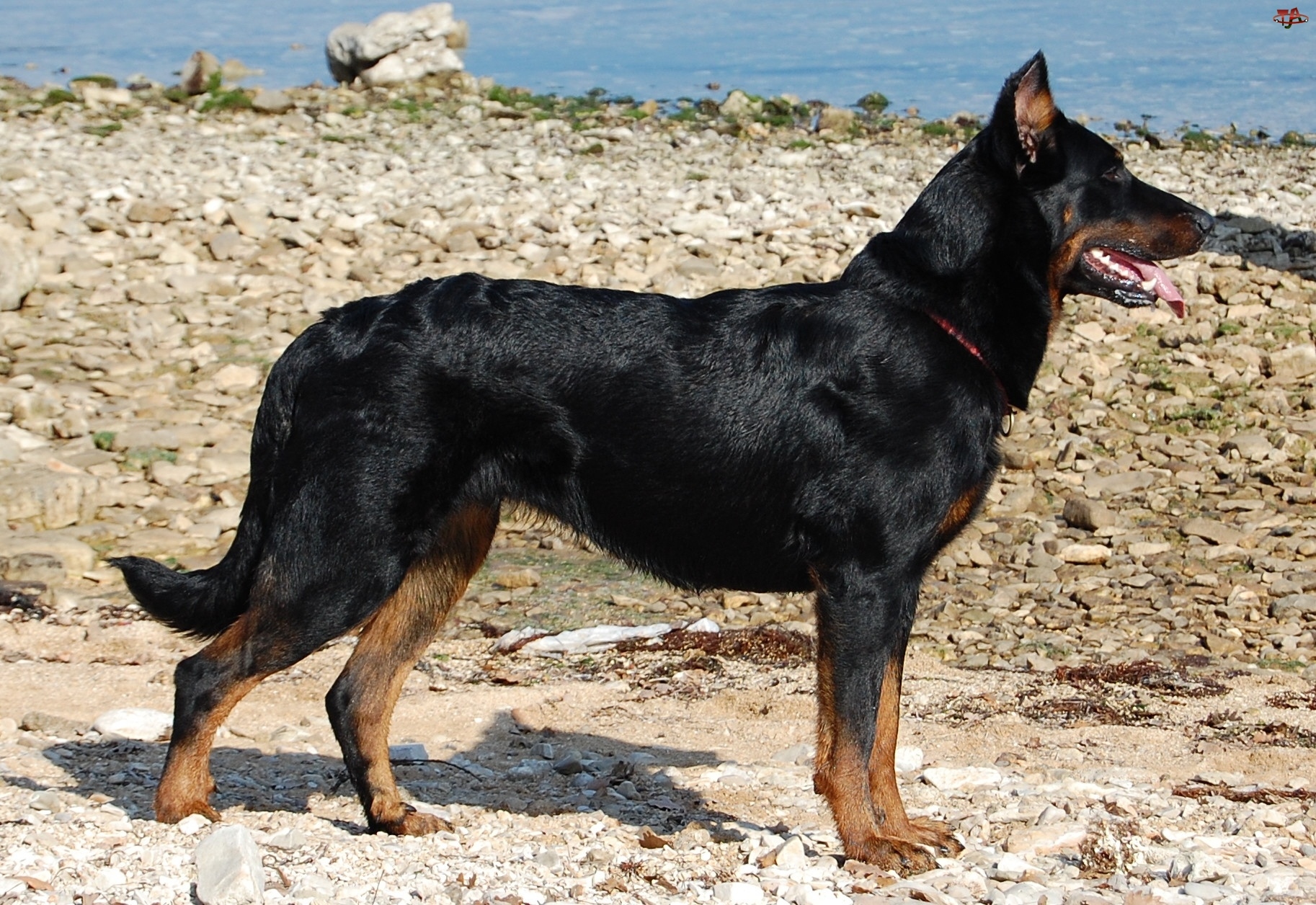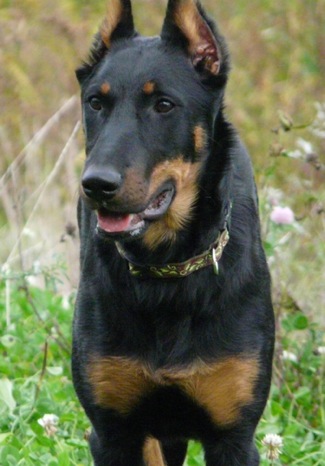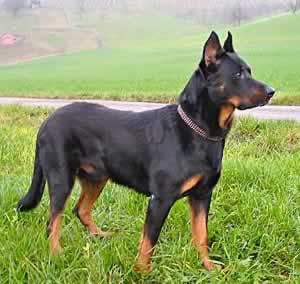
The Breed History
The Beauceron is a distinctly French herding dog, with records
going back to 1578. In 1863, Pierre Megnin differentiated, with
precision, two types of these sheep dogs: one with a long coat,
which became known as the Berger de Brie (Briard), the other with
a short coat, which is known as the Berger de Beauce (Beauceron).
The bread was accepted for AKC registration in 2007.
Breeding for Function
The Beauceron gives the impression of depth and solidity without
bulkiness; exhibiting the strength, endurance and agility required of
the herding dog. The whole conformation is a well balanced, solid dog
of good height and well muscled without heaviness or coarseness.
The dog is alert and energetic with a noble carriage. The Beauceron is
the preferred herding dog for sheep and cattle in France.
Physical Characteristics
Height at Withers: female 24 to 26.5" (61-67 cm), male 25.5 to
27.5" (65-70 cm).
Weight: females 80-95 lb (36-43 kg), males 90-110 lb (41-50 kg).
Coat: Outer coat is 1.25" to 1.5", coarse, dense and lying close to
the body. It is short and smooth on the head, ears and lower legs.
The hair is somewhat longer around the neck. Acceptable coat
colors are: Black and Rust, Black and Tan, Grey Black and Tan, and
Harlequin.
Longevity: 10-12 years.
Points of Conformation: The Beauceron is medium in all its
proportions. The length of body, measured from the point of the
shoulder to the point of the buttock, is slightly greater than the
height at the withers. The head must be in proportion with the
body, measured from the tip of the nose to the occiput it is about
40% of the height at the withers. The eyes are horizontal and
slightly oval in shape, and dark brown. The ears are set high, and
may be cropped (upright) or natural. The skull is flat or slightly
rounded near the sides of the head. The muzzle must not be narrow,
pointed, or excessively broad in width. The lips are well pigmented.
The teeth meet in a scissors bite. The tail is strong at the base,
carried down, descending at least to the point of the hock, forming
into a slight J without deviating to the right or to the left. The
feet are large, round, and compact with black nails. Hind double
dewclaws form well separated "thumbs" with nails, placed rather
close to the foot. Movement is fluid and effortless, covering ground
in long reaching strides (extended trot).
Recognized Behavior Issues and Traits
The Beauceron should be discerning and confident. He is a dog
with spirit and initiative, wise and fearless with no trace of timidity.
Intelligent, easily trained, faithful, gentle and obedient. The
Beauceron possesses an excellent memory and an ardent desire
to please his master. He retains a high degree of his inherited
instinct to guard home and master. Although he can be reserved
with strangers, he is loving and loyal to those he knows. Some will
display a certain independence. He should be easily approached
without showing signs of fear.
Normal Physiologic Variations
Merle Coat Color: Caused by a dominant mutation in the SILV
gene. Breeding two merle dogs together should be avoided, as
homozygous dogs can be born with multiple defects, including
blindness, deafness, and heart anomalies.
Harlequin Coat Color: Genetic studies on the harlequin coat color
in Beaucerons have not been carried out. However, the harlequin
coat color in Great Danes is due to the combined action of a
dominant gene H with the merle gene M in the genotype HhM+.
The H gene is a prenatal lethal when homozygous HH, so all
Harlequin Great Danes are heterozygous Hh.
Drug Sensitivities
None reported
Inherited Diseases
Hip Dysplasia: Polygenically inherited trait causing degenerative
joint disease and hip arthritis. OFA reports 14.7% affected.
Elbow Dysplasia: Polygenically inherited trait causing elbow
arthritis. OFA reports 5.5% affected.
Patella Luxation: Polygenically inherited laxity of patellar
ligaments, causing luxation, lameness, and later degenerative joint
disease. Treat surgically if causing clinical signs. Too few Beaucerons
have been screened by OFA to determine an accurate frequency.
Disease Predispositions
Hypothyroidism: Inherited autoimmune thyroiditis. 4.0% positive
for thyroid autoantibodies based on testing at Michigan State
University. (Ave. for all breeds is 7.5%).
Gastric Dilation/Volvulus (GDV, Bloat): Polygenically inherited,
life-threatening twisting of the stomach within the abdomen.
Requires immediate veterinary attention. Reported as a breed
problem on the Beauceron Club of Canada website.
Dermatomyositis-like Disease: Juvenile-onset (usually by 6
months of age) disease that initially presents with papules, pustules,
and vesicles eventuating in crusted erosions, ulcers, and alopecia.
Chronically affected Beaucerons show scarring, and either hyper or
hypopigmentation. Unknown mode of inheritance.
Epidermolysis Bullosa: Cutaneous blistering in response to trauma.
Junctional form: Affected Beaucerons show crusted papules and
erosions in genital region and at mucocutanoeuos junctions at 6
weeks. Spreads to face, pinnae, medial thighs, perianal regions, feet
and tail.
Ocular Disorders: Too few Beaucerons have been CERF examined
by veterinary ophthalmologists to determine accurate frequencies
for inherited ocular disorders. Entropion, ectropion, and progressive
retinal atrophy are reported.
Inhalant Allergies are reported.
Isolated Case Studies
Systemic Lupus Erythematosus (SLE): A six-year-old female
Beauceron presented with purulent nasal and ocular discharges,
skin lesions (including seborrhea, hyperkeratotic areas, and papules
as well as ecchymoses around the eyes, on both sides of the
pinnae, and on the vulva), generalized lymph node enlargement, a
mitral murmur, and lameness. Serum testing identified antinuclear
antibody (ANA) and antidoublestranded-desoxyribonucleic acid
(ds-DNA) antibody, confirmed SLE. She had concurrent generalized
bacterial infections.
Genetic Tests
Tests of Genotype: None available.
Tests of Phenotype: CHIC Certification: Hip radiographs, CERF eye
examination (yearly from age 2 to 8), and echocardiogram by a
cardiologist. Recommended tests include elbow radiographs, thyroid
profile including autoantibodies (annually until age 5, then every
other year), and von Willebrand's disease test.
Recommend patella evaluation.
Miscellaneous
- Breed name synonyms: Berger de Beauce, Bas Rouge, Beauce
Shepherd.
- Registries: AKC, UKC, KCGB (Kennel Club of Great Britain), ANKC
(Australian National Kennel Club), NKC (National Kennel Club), FCI.
- AKC rank (year 2008): 139 (117 dogs registered.)
- Internet resources: American Beauceron Club: www.beauce.org
Beauceron Club UK: www.beauceronclubuk.com
The Beauceron Club in Canada: www.beauceronscanada.com
Photo Gallery of Breed - Beauceron - Dog Breed








 Animalia Life
Animalia Life